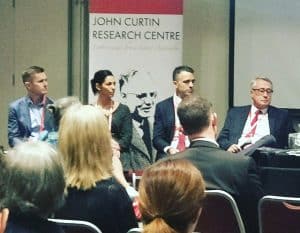
There is a range of “fringe” events happening at the


There is a range of “fringe” events happening at the
 Workplace health and safety was given only a passing mention in the speech provided by Bill Shorten at the 2018 ALP National Conference on December 16, 2018.
Workplace health and safety was given only a passing mention in the speech provided by Bill Shorten at the 2018 ALP National Conference on December 16, 2018.
In the context of workplace economics and industrial relations, some speakers mention “social investment” or “social progress” and occupational health and safety (OHS) exists in these issues
Day 1 of the Australian Labor Party conference was fascinating but unsatisfying in terms of debate on occupational health and safety matters so I spoke with one of the many exhibitors at the conference.
Glen Poole is the CEO of the Australian Men’s Health Forum and the podcast below includes a brief discussion of the importance of men’s health and the relevance of the workplace in generating and managing workplace mental health.
 This Sunday SafetyAtWorkBlog will be reporting from the 2018 National Conference of the Australian Labor Party (ALP). It promises to be extra lively as the country is only a few months away from a General Election and the ALP is tipped by most to win, or rather, the Liberal/National Coalition to lose. The intention is to watch for discussion of issues that relate to, or affect, the management of worker health and safety. There will be some, if one accepts that the most effective and sustainable occupational health and safety (OHS) solutions come from both a introduce multidisciplinary approach and that one that looks “at the source” of hazards.
This Sunday SafetyAtWorkBlog will be reporting from the 2018 National Conference of the Australian Labor Party (ALP). It promises to be extra lively as the country is only a few months away from a General Election and the ALP is tipped by most to win, or rather, the Liberal/National Coalition to lose. The intention is to watch for discussion of issues that relate to, or affect, the management of worker health and safety. There will be some, if one accepts that the most effective and sustainable occupational health and safety (OHS) solutions come from both a introduce multidisciplinary approach and that one that looks “at the source” of hazards.
The current draft National platform has a specific chapter on Safety At Work but the document is riddled with safety commitments. Curiously there is no specific mention of Industrial Manslaughter, although the ALP will
“ensure there are strong deterrents for employers who are responsible for workplace deaths”.
 The trade union movement has often been instrumental in affecting and sometimes creating government policy on occupational health and safety (OHS). The latest generation of hazards – psychosocial – can be traced back to a survey late last century of workplace stress conducted by the Australian Council of Trade Unions (ACTU). This week the ACTU released its survey into sexual harassment at work.
The trade union movement has often been instrumental in affecting and sometimes creating government policy on occupational health and safety (OHS). The latest generation of hazards – psychosocial – can be traced back to a survey late last century of workplace stress conducted by the Australian Council of Trade Unions (ACTU). This week the ACTU released its survey into sexual harassment at work.
The current survey should not be seen as representative of any social group other than trade union members even though the survey was completed by 10,000 of them. Also, this survey is far less likely to be as newsworthy as last century’s surveys as the agenda on workplace sexual harassment has already been established by reports from groups like Universities Australia and, especially, the current work by the Sexual Discrimination Commissioner and the Australian Human Rights Commission. It is also likely to be covered, probably as a secondary issue, in the various mental health inquiries scheduled for 2019.
The ACTU survey provides additional information to our understanding of sexual harassment at work but certainly not the whole picture.
 Occupational health and safety (OHS) is often about promises. Employees trust their bosses to provide them with a job and the employer promises to provide a workplace that is as safe as possible. There are also contractual policies which formalise OHS relationships between client and contractor. But OHS is more often about those more personal promises and expectations between the boss and the worker.
Occupational health and safety (OHS) is often about promises. Employees trust their bosses to provide them with a job and the employer promises to provide a workplace that is as safe as possible. There are also contractual policies which formalise OHS relationships between client and contractor. But OHS is more often about those more personal promises and expectations between the boss and the worker.
A
 Today, Siobhan McHale, Head of HR at Dulux posted a comment and video on LinkedIn about measuring cultural change. She introduces her post with:
Today, Siobhan McHale, Head of HR at Dulux posted a comment and video on LinkedIn about measuring cultural change. She introduces her post with:
“Can culture be measured? In my view it can and should be measured – in the same way as any other business activity that’s important to your success.”
The responses have been speedy and this conversation is likely to continue for sometime as McHale is monitoring the comments, some of which dispute McHale’s position.